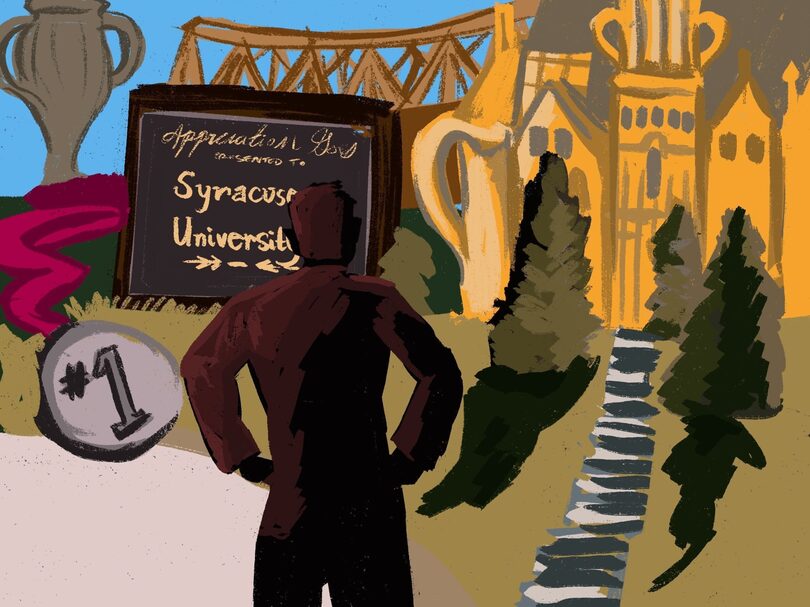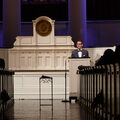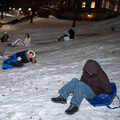Guest Column: SU recognition puts campus over community

Despite students’ efforts off campus, their work rarely earns SU’s highest honors compared to other recognitions. Our columnist argues SU should prioritize students investing in the city, not just campus, to redefine success. Julia English | Cartoonist
Get the latest Syracuse news delivered right to your inbox.
Subscribe to our newsletter here.
As graduation approaches and Syracuse University hands out more awards, medals and diplomas, I’ve begun to notice a trend: students with high GPAs, multiple leadership roles and wide campus networks consistently receive recognition. Those making an impact beyond campus in the broader Syracuse community, on the other hand, are too often overlooked.
The current model of recognition at SU overwhelmingly celebrates a specific kind of success: one that happens on campus and within student organizations, academic departments and traditional leadership pipelines. This unit of measurement not only fails to account for impact beyond titles and transcripts, but it’s also reflected in the scarcity of community-based awards compared to those focused on campus involvement. While there is an insurmountable number of awards spanning each college at SU, community recognition is scarce and campus-wide.
Some students spend their time teaching at local elementary schools, translating for refugee students in their new schools or volunteering at neighborhood food banks. Others take on caregiving responsibilities at home, set up fundraisers for local businesses or channel their passion into organizing protests. These are forms of leadership too — but they’re often left unnoticed, not just because they happen off campus, but because they don’t directly impact the day-to-day lives of most students or align with the problems the campus community prioritizes.
So, despite the empathy and initiative these services demonstrate, they’re rarely recognized by the university’s higher honors or funding opportunities. This unintentionally prioritizes students who can afford to invest their time in campus-centered leadership. Students who hold part-time jobs, take care of family members or work with community groups in the greater Syracuse area are disadvantaged. These students are often deeply committed and resourceful. However, from what I observe, their contributions don’t fit neatly into the university’s traditional molds of success, despite SU marketing itself as committed to community well-being.
As someone who has benefited from many of these awards and recognitions, I can confidently say this observation isn’t born out of bitterness but genuine dissatisfaction with a problematic pattern. I’ve sat in rooms filled with incredible, accomplished peers — but often the same kind of incredible, accomplished peers. It’s not hard to see who’s misrepresented, if represented at all. This disparity should demand more attention than the little it gets.
These students are often deeply committed and resourceful. However, from what I observe, their contributions don’t fit neatly into the university’s traditional molds of success, despite SU marketing itself as committed to community well-being.Adam Baltaxe, Guest Columnist
SU’s relationship with the city has long been fraught. Prioritizing the active celebration of students who help bridge that divide — like those mentoring high schoolers at the Northside Learning Center or organizing mutual aid drives on weekends — would be a meaningful step forward. By creating new forms of recognition, or expanding current ones, the university would not only validate these students, but also send a powerful message about the kind of impact it values.
Too often, SU functions as a bubble of privilege overlooking its surrounding city that tells a very different story. Syracuse consistently ranks among the U.S. cities with the highest poverty rates, particularly for children. Yet, students can easily spend four years here without ever stepping off campus.
The university sits just above the remains of the 15th Ward, once a thriving Black and Jewish neighborhood that was torn apart by urban renewal and the construction of I-81. That same highway now cuts through the heart of the city, contributing to economic segregation and racial inequity that still defines Syracuse today.
I’ve met students who don’t know where Salina Street is, let alone the significance of the 15th ward and other neighborhoods that surround us or the long history of displacement and disinvestment in this city. We’re barely told about the Onondaga people who were here first — outside of the occasional land acknowledgement — or how our presence affects the communities that have called this place home far longer than we have.
The university doesn’t ask students to engage with Syracuse the city. It instead encourages them to live, eat, study and lead entirely within the boundaries of University Hill. This disconnect leaves us complicit in a harmful dynamic.
And it isn’t just noticed by students who seek to mend it — it’s felt deeply by those who called Syracuse home long before setting foot on SU campus.
Abdiweli Dahir, an SU Senior and lifelong resident of the city said: “When campus is a ‘bubble,’ students feel disconnected from the city of Syracuse. This leads to the residents of the city not having a sense of community with students.”
His words reflect a broader frustration that the university’s insularity doesn’t just limit student experiences; it actively damages the sense of common belonging that could exist between the Hill and the neighborhoods around it.
Students remain unaware of the city’s cultural richness and ongoing struggles because there’s little institutional effort to educate or immerse us in it.
Over the past year, I’ve volunteered with the Refugee Assistance Program, or “Bob’s School,” in downtown Syracuse, helping refugee adults adjust to life in the city. Through this work, I’ve spoken with dozens of city residents — refugees, teachers and neighbors — who hold overwhelmingly negative views of the university. Many feel SU takes up too much attention and all of the city’s resources without giving anything back.
I believe this can change. If the university were to prioritize and incentivize students who invest in the city of Syracuse and not just SU, it wouldn’t just improve student recognition. It would improve the university’s reputation, its relationships and the real-world relevance of the education it has to offer. And just as importantly, the city would benefit from an influx of energized young people who show up not as tourists or temporary visitors, but as neighbors.
A university’s prestige shouldn’t be measured only by how many awards it gives to its top students, but by how well it uplifts a broad range of talents and passions. It’s time SU expanded its definition of success.
Adam Baltaxe is a senior majoring in international relations and spanish language, literature and culture. He can be reached at abaltaxe@syr.edu






